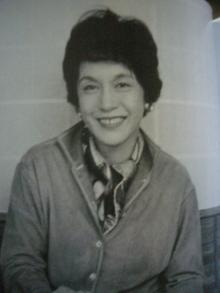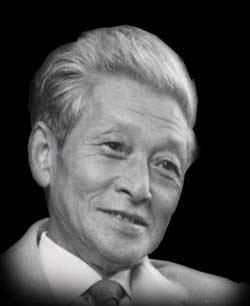It was therefore a good thing that my best friend Shinya Shirasu went ahead with the arts exhibition that he produced and curated himself. The exhibition opened 8 days after the earthquake hit Tohoku area, in the Setagaya Art Museum in western Tokyo.
Shinya comes from a very privileged family background. Shinya's grandfather, Jiro Shirasu, from whom he perhaps inherited the ragged good looks, became famous for his active role in "nation building" after the end of Second World War.
Jiro Shirasu was educated at Cambridge, made friends with British upper class. Upon returning to Japan, he foresaw that the war with the United States was inevitable, no matter how unwise that action was. Shirasu also predicted that Japan would lose the war, a perception he presumably and well-advisedly kept to himself given the raging nationalistic sentiments at that time. Shirasu retreated himself into the suburb, bought a farm, and lived a life of a "country gentleman". In the legendary country house ("Buaiso", now a museum open to the public) Shirasu kept the quiet style of a hermit, keeping a distance from the wartime government of Japan.
On 15th August 1945, Emperor Showa (then Emperor Hirohito) delivered the famous "Gyokuon hoso" ("Jewel voice broadcast") over the radio, which effectively announced the Japanese surrender. Shortly after that, when the long-time friend and mentor Shigeru Yoshida was appointed Prime Minister, Shirasu's active political life began, which made his name in history.
Shirau was appointed as an advisor at the Central Liaison Office, which had the important mission of negotiating with the General Head Quarters led by General McArthur. Shirasu had a substantial role in the formation of the new Constitution of Japan, which was drafted amid dense and often heated negotiations between the GHQ and Japanese government.
At a time when most Japanese obeyed the orders of the American conquerors without questions, Shirasu was described as the "only defiant Japanese", who sometimes defied GHQ orders as a man of principles.

Jiro Shirasu (from http://bit.ly/g7xe4f )
65 or something years later, Shinya Shirasu sometimes reminds one of the defiance of his grandfather. Shinya has just gone ahead with the arts exhibition ("Prayers to nature") against the wave of event and meeting cancellations after the earthquake. This particular exhibition commemorates the centennial anniversary of the birth of his grandmother, Masako Shirasu. Masako was married to Jiro Shirasu, an art lover with a good taste and essayist with a soul, famous in her own right.
Shinya's grandfather on his mother's line was the great literary critic Hideo Kobayashi, who established almost singlehandedly the modern Japanese prose style of critical essays. Auditory records of Kobayashi's lectures, now available on CDs, are "The Old Testament" of Japanese public speech. Hideo Kobayashi's daughter married with a son of Jiro and Masako Shirasu, giving birth to Shinya and his younger sister. Given such a background, it is fair to say that Shinya is truly a "royal straight flush" of Japanese culture, as I am wont to say rather teasingly to Shinya.)

Masako Shirasu (from http://amba.to/goQ0vc )

Hideo Kobayashi (from http://bit.ly/dSIkhA)

Shinya Shirasu (from http://bit.ly/9wTqoy)
On the afternoon of 18th March 2011, exactly one week after the earthquake hit, Shinya held the opening ceremony at the Setagaya Art Museum. It was a difficult day, which is perhaps an understatement. The public transportation in Tokyo was still chaotic, and there was this (both in psychological and practical terms) very real danger of then ongoing nuclear crisis at Fukushima Daiichi. I decided to go, for friendship's sake. I knew how much energy and passion Shinya Shirasu has put into the preparation of this exhibition. Friends stand by friends at difficult times.
One of the masterpieces on exhibition was the "Jitsugetsu sansui-zu" ("Sun, moon, mountains, and water") screen dating from the 16th century, which Shinya's grandmother Masako Shirasu "discovered" in a temple in western Japan and brought to the public's attention through her essays.
Opportunity to see this famous screen at first hand is rare and far in-between, except at special exhibitions like this one. Kongoji temple in the south of Osaka city, which has been protecting this precious piece of art into modern times, exhibits it only on two designated days a year, acting on quite understandable intentions of preserving a irreplaceable cultural heritage.
Thus, it was with great anticipations that I went to the Setagaya Art Museum on the day of opening ceremony, despite concerns for the ongoing crisis at the Fukushima Daiichi Nuclear Plant.
Setagaya Art Museum is situated in the spacious Kinuta Park. It has its own backup electricity supply, a factor which helped the head of museum to make the laudable decision to go ahead with the exhibition. Once surrounded by the park greens, I felt my nervous system noticeably relax. I realized only then how strenuous these days had been, after the great earthquake, in the shadow of the appalling damage that has been done and the imminent crisis at the nuclear plant.
I met Shinya in front of the Museum. "Congratulations, my friend!" I said to Shinya, shaking his hand. Shinya was dressed in a handsome suit, welcoming guests with a big smile, but not without his characteristic shyness.
"There will be no drinks provided. The party is cancelled for today because of the earthquake, sorry!" Shinya said to me in a whisper. "Only the exhibitions, I'm afraid". "Don't worry", I said. "I will buy you a drink when things have settled down." "You say you haven't brought any good wines for me today?" Shinya said, jokingly, with twinkles in his eyes. "Wait some time", I said. "Today's art works only, as you've just said yourself. Drinks later!"
What warmth! It is those small talks that keep life going! I waved Shinya a temporal see you. The doors were now open. Guided by museum attendants, we went into the halls to admire the collection of artworks curated by Shinya, many of them expressions of prayers, dedicated to the joys and sorrows of life.
There it was, in the dimly but sufficiently lit room, the "Sun, moon, mountains, and water" screen. It was a particularly poignant time to admire its magnificence. Most probably once in a lifetime, as I suspect would become evident many years from now, when I look back on the difficult times of the past through the rosy windowpane of recollection.
Standing in front of the masterpiece, my attention was immediately drawn to the fact that the "waves" in the lower half of the painting reminds one of tsunami. This realization was perhaps not entirely due to associations made by the over-sensitive nerves after the earthquake. It also had, I suspect, a much deeper resonance.
The identity of the creator of the "Sun, moon, mountains, and water" screen is now lost. Mystery surrounds its origin. It is difficult to pin down exactly what contexts were behind this impressive portrayal of nature. Today, one can just stand, admire, and feel, explore, and implore. One then feels that the philosophy behind the screen is the ethos "everything is connected". Not only the trees on the mountains, the flowers blossoming on the boughs, but also the rocks and waters, moon and the sun. They are all living, vibrating, anticipating and responding to the existence of each other, connected. There is no division. Everything in this world is connected. No life and death.
Therein perhaps lies the truth, a truth that is probably too terrible to face, too harsh to be taken into the calm speech of daily life.
The tsunami waters waited for hundreds of years to reach the deep inlands. When they finally made their ways, had the time of their lives, a terrible tragedy was wrought upon the innocent lives of tens of thousands, quite unintended, but strictly prescribed by the laws of nature.
Sun, moon, mountains, water, and me. Lost for words in front of the screen, I could only pray.
This world is such a cruel place. And yet, through still unknown miraculous steps, life and beauty somehow descend to the earth.
On day 8 after the earthquake, I was witnessing a magnificent portrait of the miracle of existence in an art museum in Tokyo, under the shadow of developing nuclear crisis. The radioactive materials are perhaps having the time of their life now, I thought, released after such a long period of confinement.
Please, I prayed, please be it so that we could live and let live. Let us somehow overcome, because, even if, everything in this world is connected.


"Jitsugetsu sansui-zu" ("Sun, Moon, Mountains and Water") screen, the left (above) and the right (below) panels (from http://bit.ly/fcfJiC)
4 comments:
I have really been a longtime admirer of this screen, but had not been aware it is on display now.
Wonderful post.
"There is no division. Everything in this world is connected. No life and death."
My grandmother was a daughter of a Shinto priest and I learned from her that eveything in this world has a meaning. There is a meaning to death; there is a meaning to be alive. Like the butterfly effect in chaos/complexity theory, our existence is part of the complex system that has its causes and its consequences. As I read this article, I come to think that perhaps the "meaning of life and death" I learned from grandma was a religious, philosophical interpretation of "the law of nature."
Thank you for sharing your live impression of "Jitsugetsu sansui-zu".
Everything is waving.
It reminds me tremendous energy of nature.
When you first introduced us to the masterpiece on this blog, I appreciated it as a cosmic blessing.
Now it appears to me to be chaotic and dynamic.
The left panel assumes a sense of mortality and the right shines from the beyond.
"Everything in this world is connected.
No life and death."
These words fit perfectly into our present emotion and the background of the masterpiece.
I also applaud Mr.Shirasu's decision to have held the exhibition !
"The idea is that there is a kind of memory in nature. Each kind of thing has a collective memory. So, take a squirrel living in New York now. That squirrel is being influenced by all past squirrels." - Dr Rupert Sheldrake
Yes, we're all connected, in one way or another. Past, present and future experiences, all are the same at this very instant, for all of us. We all are part of that natural memory. After all we are part of nature.
Thank you for sharing this.
Post a Comment